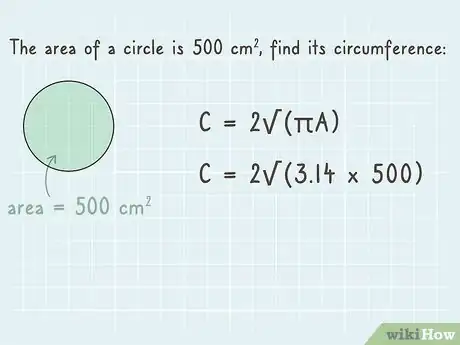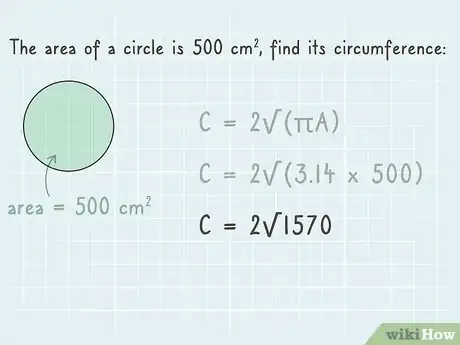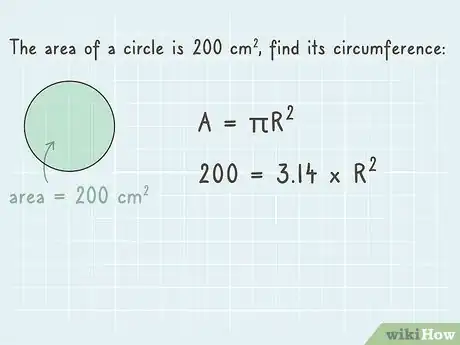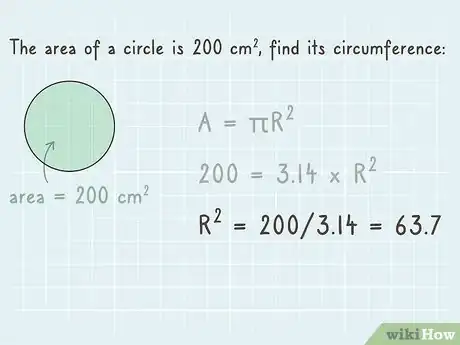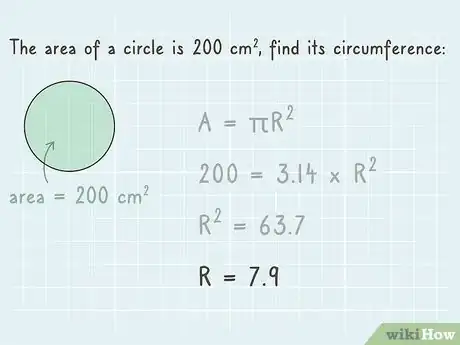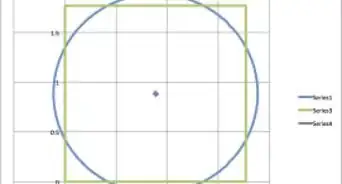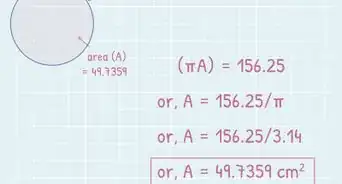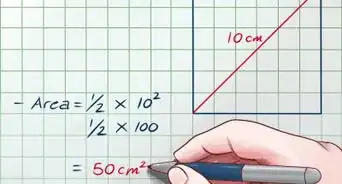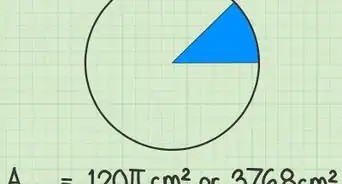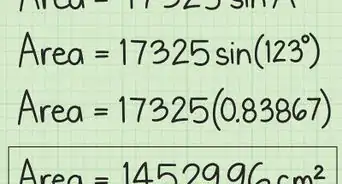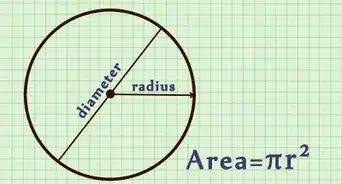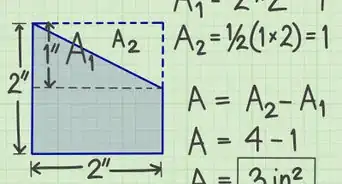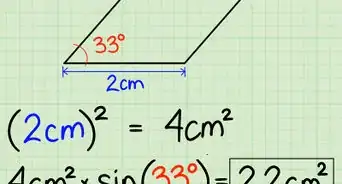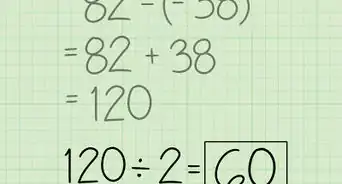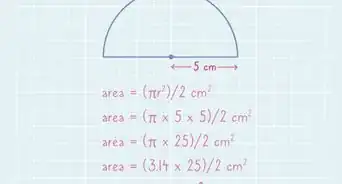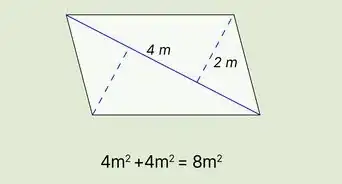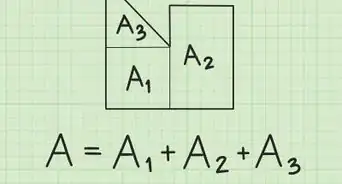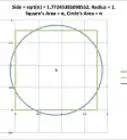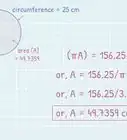This article was co-authored by Grace Imson, MA. Grace Imson is a math teacher with over 40 years of teaching experience. Grace is currently a math instructor at the City College of San Francisco and was previously in the Math Department at Saint Louis University. She has taught math at the elementary, middle, high school, and college levels. She has an MA in Education, specializing in Administration and Supervision from Saint Louis University.
There are 8 references cited in this article, which can be found at the bottom of the page.
This article has been viewed 214,317 times.
The formula for calculating the circumference (C) of a circle, C = πD or C = 2πR, is simple if you know the circle's diameter (D) or radius (R). But what do you do if you only know the circle's area? Like many things in math, there are multiple solutions to this problem. The formula C = 2√πA is designed to find a circle's circumference using the area (A). Alternatively, you can solve the equation A = πR2 in reverse to find R, then plug R into the circumference equation. Both equations provide the same result.
Steps
Using the Circumference Equation
-
1Set up the formula C = 2√πA to solve the problem. This formula calculates the circumference of a circle if you only know its area. C represents the circumference, and A represents the area. Set this formula up to begin solving the problem.[1]
- The π symbol, which stands for pi, is a repeating decimal that has thousands of place values. For simplicity, use 3.14 to represent pi.[2]
- Since you need to convert pi to its numerical form anyway, plug 3.14 into the equation from the start. Write it as C = 2√3.14 x A.
-
2Plug the area into the A position of the equation. Since you already know the area of the circle, plug that into the A position. Then proceed to solve the problem using the order of operations.[3]
- Let’s say the area of the circle is 500 cm2. Set up the equation as 2√3.14 x 500.
Advertisement -
3Multiply pi by the area of the circle. In the order of operations, the operations inside the square root symbol go first. Multiply pi by the area of the circle that you plugged in. Then plug that result into the equation.[4]
- If our equation was 2√3.14 x 500, then 3.14 times 500 is 1,570. This now makes the equation 2√1,570.
-
4Find the square root of the sum. There are multiple ways to calculate square root. If you’re using a calculator, press the √ function and type the number. You can also work the problem out by hand using prime factorization.[5]
- The square root of 1,570 is 39.6.
-
5Multiply the square root by 2 to find the circumference. Finally, complete the formula by multiplying the result by 2. This leaves you with a final number, which is the circle’s circumference.[6]
- Multiply 39.6 by 2, which is 79.2. This means that the circumference is 79.2 cm, and you’ve solved the equation.
Solving the Problem in Reserve
-
1Set up the formula A = πR2. This is the formula to find the area of a circle. A represents the area, and R represents the radius. Normally, you’d use it if you knew the radius, but you can also plug in the area to reverse-solve the equation.[7]
- Again, use 3.14 to represent pi.
- Remember—the radius spans from the center of a circle to the rim.[8]
-
2Plug the area into the A position of the equation. Use whichever number you know represents the circle's area. Put it on the left side of the equation in the A position.[9]
- Let's say the area of the circle is 200 cm2. The formula would be 200 = 3.14 x R2.
-
3Divide both sides of the equation by 3.14. To solve equations like this, gradually eliminate steps from the right side by performing the opposite operations. Since you know the value of pi, divide each side by that value. This eliminates pi from the right side, and gives you a new numerical value on the left side.[10]
- If you divide 200 by 3.14, the result is 63.7. This makes the new equation 63.7 = R2.
-
4Find the square root of the result to get the circle's radius. Next, get rid of the exponent on the right side of the equation. The opposite of squaring a number is finding the square root of the number. Find the square root of each side of the equation. This eliminates the exponent on the right side and gives you the radius on the left side.[11]
- The square root of 63.7 is 7.9. This makes the equation 7.9 = R, meaning that the radius of the circle is 7.9. This gives you all the information you need to find the circumference.
-
5Find the circumference of the circle using the radius. There are 2 formulas to find circumference (C). The first is C = πD, where D is the diameter. Multiply the radius by 2 to find the diameter. The second is C = 2πR. Multiply 3.14 by 2, then multiply it by the radius. Both formulas give you the same result.[12]
- Using the first option, 7.9 x 2 = 15.8, the diameter of the circle. This diameter times 3.14 is 49.6.
- For the second option, set up the equation as 2 x 3.14 x 7.9. First, 2 x 3.14 is 6.28, and that multiplied by 7.9 is 49.6. Notice how both methods give you the same answer.
Community Q&A
-
QuestionCan I have an explanation of how to find circumference of a circle using area?
 DonaganTop AnswererAs explained above: (1) Divide the area by 3.14 (pi). (2) Find the square root of that number. That is the radius. (3) Multiply by 6.28 (twice pi). That's the circumference.
DonaganTop AnswererAs explained above: (1) Divide the area by 3.14 (pi). (2) Find the square root of that number. That is the radius. (3) Multiply by 6.28 (twice pi). That's the circumference. -
QuestionI still didn't get it. Could you give a better explanation?
 DonaganTop AnswererYou're given the area. Divide by pi (3.14). That gives you the square of the radius. Find the square root. That's the radius. Double it. That's the diameter. Multiply by pi (3.14). That's the circumference.
DonaganTop AnswererYou're given the area. Divide by pi (3.14). That gives you the square of the radius. Find the square root. That's the radius. Double it. That's the diameter. Multiply by pi (3.14). That's the circumference. -
QuestionHow do I find the square root?
 DonaganTop AnswererUse a calculator, if that's not prohibited. Otherwise, see the wikiHow article Calculate a Square Root by Hand.
DonaganTop AnswererUse a calculator, if that's not prohibited. Otherwise, see the wikiHow article Calculate a Square Root by Hand.
References
- ↑ https://www.omnicalculator.com/math/circle
- ↑ https://sciencing.com/calculate-area-circumference-circle-7274267.html
- ↑ https://www.omnicalculator.com/math/circle
- ↑ https://www.omnicalculator.com/math/circle
- ↑ https://www.cuemath.com/algebra/squares-and-square-roots/
- ↑ https://www.cuemath.com/geometry/circumference-of-a-circle/
- ↑ https://sciencing.com/calculate-area-circumference-circle-7274267.html
- ↑ https://www.ncl.ac.uk/webtemplate/ask-assets/external/maths-resources/core-mathematics/geometry/geometry-of-a-circle.html
- ↑ https://sciencing.com/calculate-area-circumference-circle-7274267.html

